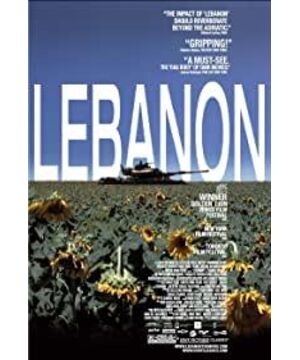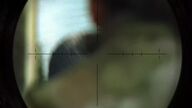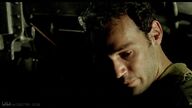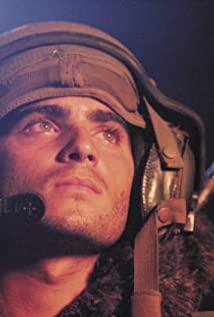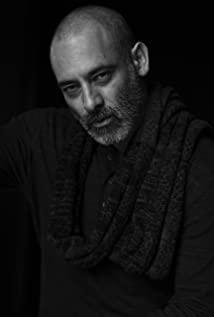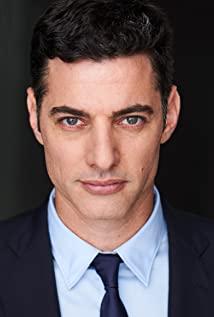The embers after the explosion, a dying donkey in a pool of blood is no longer struggling, only the slightly opened nostrils and the tears that flow down remind people that it is still a living thing at this moment-but it is in endless torture and Waiting for death in pain.
This shocking subjective shot through the muzzle of the tank comes from the 2009 Venice Film Festival Golden Lion Award-winning work "Lebanon".
Because of the extreme filming methods used in that forgotten war, this masterpiece 11 years ago has almost been forgotten by the world. However, the loud noise on August 4, 2020 reminds people once again: under the same sky, catastrophes repeat themselves all the time.
With a flick of a finger, everything was wiped out. The rising mushroom cloud casts a terrifying "glass rain", as if the end of the world: more than 150 people died, 5,000 were injured, and 300,000 people were left homeless; the mayor who wept bitterly, the bride who returned to her place, and the devastation. An independent old lady in her home who plays the piano by herself...This scene of scenes that moved the viewer, fixed the fragility and impermanence of life, the sorrow and tenacity of life together in the minds of hundreds of millions of people. People who are bathed in peace should be grateful for everything instead of getting used to it. After all, the numb nerves will make people gradually forget: what a blessing to live in itself.
The stories that touch the bottom of my heart seem to be able to find a trace in the movie. The tragic reality is often more heartbreaking than the movie. The big explosion at Beirut port is as powerful as a small nuclear war, making Lebanon, which is already in deep economic crisis and political turmoil, and struggles to deal with the new crown epidemic worse. As everyone knows: Lebanon-Israel conflict has a long history, and gunfire is commonplace. Just the day before the explosion, there was a serious border conflict between the two sides. Therefore, many Lebanese citizens mistakenly believed that Israel fired missiles to the country at first. But soon, Israel clarified that it had nothing to do with the explosion. The focus of attention has also fallen from the suspicion of war to why 2,700 tons of ammonium nitrate have been stored in a warehouse for six years.
This unprecedented explosion once again exposed Lebanon's survival dilemma for many years to the world. In fact, some people have long set their sights on this troubled country: "Lebanon" director Samuel Mautz was originally an Israeli. As a tank gunner, he participated in the Lebanon War in 1982—Israel’s at the time. The ambassador to Britain was assassinated by Palestinian armed forces, so Israel dispatched hundreds of thousands of navy, army and air forces to launch a fierce attack on the Palestine Liberation Organization and the Syrian army in Lebanon in an attempt to control southern Lebanon and establish a security buffer zone. After 27 years, Maoz, who was deeply troubled by the aftereffects of the war, finally confronted his heart demon for many years and put his own experience on the big screen. The movie "Lebanon" is unique among many war films, first of all, because it originated from the director's real life experience.
Unlike conventional war films, which spread a protracted timeline and focus on magnificent war scenes and complex groups of sentient beings, the story of "Lebanon" is so simple that it takes place in one day and one night (at this point, only the recent "Dunkirk" and "1917" is similar): Four Israeli "rookie" recruits with no combat experience drove a tank and followed the infantry squad through Lebanese villages all the way to clear the "PLO" terrorists they encountered anytime and anywhere. . Unexpectedly, the tank soldiers lost contact with the combat troops on the way and fell into a circle of Syrians.
Simpler than the plot is the setting of "Lebanon": Except for the large dazzling sunflower on the poster, there are only two in the whole film-the small and dirty tank interior and the circle peeking out through the muzzle scope.形窗。 Shaped window. Putting the whole film in a closed and isolated space, only the gunner’s subjective perspective extends outwards. This simple and unique lens design can't help but make people amazing: the film can still be shot like this!
The first half of the film mainly shows the combat journey that has been sheltered by "iron armor": when terrorists disguised as civilians drove into the field of tank soldiers in a small car, the ground commander issued an order to fire, but "normal training only fights." The gunner Shulink, who has never killed anyone, was frightened by the sudden situation.
A moment of hesitation and intolerance, in exchange for the enemy's gunshots, Shulink watched his comrade-in-arms fall and died of serious injuries.
When a pickup truck appeared again in the front, the furious commander urged Shulink to "kill it without warning." Shulink, who was in a panic, fired a cannonball.
But this time, it was a truck loaded with chickens, and the poor old farmer was blown off his hands and feet, lingering and howling on the ground. Shulink’s comrades could not help but immediately stepped forward to fill in two shots: at this moment, it is meaningless to distinguish between the enemy, the prisoner of war or the civilian.
During the third mission, a family hijacked by terrorists was in the scope. The hostages begged hard, the enemy frantically clamored, and the officer urged to open fire. Shulink's tormented heart was once again caught in a struggling battle between heaven and man.
He fired at the smallest possible sacrifice. The terrorist was shot dead on the spot, but the surviving woman still lost her husband and 5-year-old child.
The round window with the palm of the hand is the only channel for soldiers to communicate with the outside world. The sight of the sight is full of magnified human tragedies. From the beginning of the film, the director Mao Ci forced all the audience to jump into the tank with him, put themselves in it, and return to the bloody and tragic killing battlefield. With the subjective perspective of the gunner moving up and down, every audience can experience the anxiety and pain between the inside and the outside, the heart-piercing hesitation and pain.
We have all become the "killers" behind the scope, facing each of the victims: there is no emotion on their faces, there is no gloss in their eyes, the usual horror has caused incredible numbness, only the flesh and blood of the broken arm. Fly by, their eyes will see a little light of fear and hatred.
Although the tank isolates the four protagonists from the surrounding war, this seemingly independent claustrophobic space is far from indestructible: the clear face is gradually surrounded by black oil stains, and the hands that hold the power of life and death tremble too much. They weren't heroes who turned the tide and murdered like hell. They were just forced to get involved in a war they couldn't face and couldn't imagine.
After a period of time, the tank was hit by a Syrian rocket artillery. Although it was not damaged internally, it could no longer be moved. The tank soldiers immediately lost contact with the infantry. Since then, the lives of the four people have been firmly tied to the almost scrapped tank, and the dull and depressing confined space has also provided a broader platform for the struggle of human nature.
In war films like "Furious", the audience only sees how majestic tanks on the battlefield are, killing all quarters, but there are few films that show the real life and mental state of tank soldiers: although the inner wall of the tank is engraved with these two lines: " A tank is just a soldering iron, and the body of a soldier is comparable to steel", but in this film, life is equally fragile whether inside or outside the soldering iron: the four people who have become scared birds are trapped on all sides, isolated and helpless. The spirit gradually collapsed.
The overall tone of "Lebanon" is gloomy and dim, the picture is rough and shaky, and the frequent switching between close-ups of the face and the telephoto lens makes the film filled with an anxious breath of death from beginning to end. Due to the limitation of the “not inside or outside” scene, when the tank is in an ambush in the dark, we can only hear the huge roar of the machine, and we can’t see the sound of the battle outside the tank. "The shooting technique has greatly expanded people's imagination of the space outside the painting.
Similar to the well-received "Bomb Disposal Unit" a year ago, "Lebanon" has greatly weakened the political stance of war. It does not try to explore the right and wrong of the warring parties, but instead focuses on portraying the contradictions and plights of those who experienced the war. The story of "Lebanon" can take place in any corner of the world. The important thing is: ordinary people at a loss are pushed to the battlefield, but how the will to survive step by step cannibalize their psychological defenses, and finally in When life was hanging by a thread, it evolved into unscrupulous and endless killing.
Not crazy, not live. Step onto the battlefield and join a life-threatening gamble. Maoz reproduced his unbearable and nightmare memories with the most realistic and unprecedented art form. Every audience can experience his fear, his suffering and his war at close range.
The most unique shooting method combined with the purest personal memory: no irony, no humanity, no sympathy, or even thinking, everything that has nothing to do with personal survival does not exist-and this is the true appearance of war: being a Being in a tank or in a street full of artillery fire, all rational thinking about the metaphysics of war is extravagant. For the parties involved in the war, they can only consider two options: busy living or busy dying.
Therefore, it is difficult to say that "Lebanon" is a good-looking war film, because a real war is never "good-looking". Those of us who have never experienced the battlefield, whenever we watch movies about war, we only resort to imagination: the lingering love in "Pearl Harbor"; the intense confrontation in "Black Hawk Down"; the painful reflection in "The Flag of Fathers". ..... But no matter how empathy or contemplation, we are ultimately outsiders on the battlefield.
"Lebanon" is different. You can like or reject it, but you can't ignore that it comes from an "insider"'s deep understanding that war comes from the heart: if one's life is also life, all wars are meaningless.
After the dying struggle of the bullet rain, the stalled tank finally started again, and the tank soldiers made a bloody way in the left and right rush, blind hit and accidental collision. It was not until the end of the film that we ushered in the sun of dawn the next day. Tanks and flowers are combined with a strong visual impact. The strong contrast of light inside and outside makes people realize the difference between life and death. It turned out that the sunflower that fluttered in the wind but bowed down under the blue sky was so beautiful.
View more about Lebanon reviews


